Insight into Pelargonium odoratissimum Essential Oil Preservative Properties Effect on Ground Beef
Abstract
:1. Introduction
2. Materials and Methods
2.1. Sample
2.2. GC-MS Analyses of EO
2.3. Antioxidant and Antibacterial Activity
2.3.1. DPPH Assay
2.3.2. Determination of Inhibition Diameters
2.3.3. Determination of Minimum Inhibitory Concentrations
2.3.4. Determination of Minimum Bactericidal Concentrations
2.4. Analysis Conditions for Minced Ground Beef Samples
2.5. Microbial Load Changes
2.6. Physicochemical Changes
2.6.1. pH Analysis
2.6.2. Protein and Lipid Oxidation Analysis
2.7. Sensory Evaluation
2.8. Statistical Analysis
3. Results
3.1. GC-MS Analyses
3.2. Antibacterial Activity
3.3. Antioxidant Activity
3.4. Effect of POEO on Conservation of Raw Minced Beef Meat
Changes in Microbial Status of Meat Samples
3.5. Physiochemical Analysis
Changes in MetMb and TBARS of Raw Ground Beef Samples
3.6. Changes in pH of Raw Ground Beef Samples
3.7. Effect of POEO on Sensory Attributes of Raw Ground Beef Samples
3.8. Principal Component Analysis (PCA)
3.9. Heatmap
4. Conclusions
Author Contributions
Funding
Institutional Review Board Statement
Informed Consent Statement
Data Availability Statement
Acknowledgments
Conflicts of Interest
References
- ur Rahman, U.; Sahar, A.; Ishaq, A.; Aadil, R.M.; Zahoor, T.; Ahmad, M.H. Advanced Meat Preservation Methods: A Mini Review. J. Food Saf. 2018, 38, e12467. [Google Scholar] [CrossRef]
- Sridhar, A.; Ponnuchamy, M.; Kumar, P.S.; Kapoor, A. Food Preservation Techniques and Nanotechnology for Increased Shelf Life of Fruits, Vegetables, Beverages and Spices: A Review. Environ. Chem. Lett. 2021, 19, 1715–1735. [Google Scholar] [CrossRef] [PubMed]
- Rudy, M.; Kucharyk, S.; Duma-Kocan, P.; Stanisławczyk, R.; Gil, M. Unconventional Methods of Preserving Meat Products and Their Impact on Health and the Environment. Sustainability 2020, 12, 5948. [Google Scholar] [CrossRef]
- Kaale, L.D.; Eikevik, T.M.; Rustad, T.; Kolsaker, K. Superchilling of Food: A Review. J. Food Eng. 2011, 107, 141–146. [Google Scholar] [CrossRef]
- Taieb Bouteraa, M.; Ben Akacha, B.; Kačániová, M.; Čmiková, N.; Ben Romdhane, W.; Baazaoui, N.; Soltani, N.; Chouaibi, Y.; Ben Hsouna, A.; Garzoli, S.; et al. Exploring the Antimicrobial and Antioxidant Properties of TdGASA2 Protein: From Molecular Insights to a Promising Natural Preservative for Tunisian Cheese Shelf-Life Enhancement. Food Biosci. 2024, 61, 104884. [Google Scholar] [CrossRef]
- Jha, P.K.; Sadot, M.; Vino, S.A.; Jury, V.; Curet-Ploquin, S.; Rouaud, O.; Havet, M.; Le-Bail, A. A Review on Effect of DC Voltage on Crystallization Process in Food Systems. Innov. Food Sci. Emerg. Technol. 2017, 42, 204–219. [Google Scholar] [CrossRef]
- Soyer, A.; Özalp, B.; Dalmış, Ü.; Bilgin, V. Effects of Freezing Temperature and Duration of Frozen Storage on Lipid and Protein Oxidation in Chicken Meat. Food Chem. 2010, 120, 1025–1030. [Google Scholar] [CrossRef]
- Ben Akacha, B.; Michalak, M.; Ben Romdhane, W.; Kačániová, M.; Ben Saad, R.; Mnif, W.; Kukula-Koch, W.; Garzoli, S.; Ben Hsouna, A. Recent Advances in Phytochemistry, Pharmaceutical, Biomedical, Phytoremediation, and Bio-Preservative Applications of Lobularia maritima. S. Afr. J. Bot. 2024, 165, 202–216. [Google Scholar] [CrossRef]
- Boler, D.D.; Woerner, D.R. What Is Meat? A Perspective from the American Meat Science Association. Anim. Front. 2017, 7, 8–11. [Google Scholar] [CrossRef]
- Fratianni, F.; De Martino, L.; Melone, A.; De Feo, V.; Coppola, R.; Nazzaro, F. Preservation of Chicken Breast Meat Treated with Thyme and Balm Essential Oils. J. Food Sci. 2010, 75, M528–M535. [Google Scholar] [CrossRef]
- Gómez, I.; Janardhanan, R.; Ibañez, F.C.; Beriain, M.J. The Effects of Processing and Preservation Technologies on Meat Quality: Sensory and Nutritional Aspects. Foods 2020, 9, 1416. [Google Scholar] [CrossRef] [PubMed]
- Sun, S.; Rasmussen, F.D.; Cavender, G.A.; Sullivan, G.A. Texture, Color and Sensory Evaluation of Sous-Vide Cooked Beef Steaks Processed Using High Pressure Processing as Method of Microbial Control. LWT 2019, 103, 169–177. [Google Scholar] [CrossRef]
- Chaari, M.; Elhadef, K.; Akermi, S.; Ben Akacha, B.; Fourati, M.; Chakchouk Mtibaa, A.; Ennouri, M.; Sarkar, T.; Shariati, M.A.; Rebezov, M.; et al. Novel Active Food Packaging Films Based on Gelatin-Sodium Alginate Containing Beetroot Peel Extract. Antioxidants 2022, 11, 2095. [Google Scholar] [CrossRef] [PubMed]
- Ben Akacha, B.; Garzoli, S.; Ben Saad, R.; Brini, F.; Mnif, W.; Kačániová, M.; Ben Hsouna, A. Biopreservative Effect of the Tunisian Halophyte Lobularia maritima Flavonoid Fraction, Used Alone and in Combination with Linalool in Stored Minced Beef Meat. Metabolites 2023, 13, 371. [Google Scholar] [CrossRef]
- Ben Akacha, B.; Michalak, M.; Najar, B.; Venturi, F.; Taglieri, I.; Kačániová, M.; Ben Saad, R.; Mnif, W.; Garzoli, S.; Ben Hsouna, A. Recent Advances in the Incorporation of Polysaccharides with Antioxidant and Antibacterial Functions to Preserve the Quality and Shelf Life of Meat Products. Foods 2023, 12, 1647. [Google Scholar] [CrossRef]
- Goudarzi, J.; Moshtaghi, H.; Shahbazi, Y. Kappa-Carrageenan-Poly(Vinyl Alcohol) Electrospun Fiber Mats Encapsulated with Prunus domestica Anthocyanins and Epigallocatechin Gallate to Monitor the Freshness and Enhance the Shelf-Life Quality of Minced Beef Meat. Food Packag. Shelf Life 2023, 35, 101017. [Google Scholar] [CrossRef]
- Fernández-López, J.; Viuda-Martos, M. Introduction to the Special Issue: Application of Essential Oils in Food Systems. Foods 2018, 7, 56. [Google Scholar] [CrossRef]
- Prakash, B.; Kedia, A.; Singh, A.; Yadav, S.; Singh, A.; Yadav, A.; Deepika; Dubey, N.K. Antifungal, Antiaflatoxin and Antioxidant Activity of Plant Essential Oils and Their In Vivo Efficacy in Protection of Chickpea Seeds: Essential Oils as Food Preservatives. J. Food Qual. 2016, 39, 36–44. [Google Scholar] [CrossRef]
- Bhavaniramya, S.; Vishnupriya, S.; Al-Aboody, M.S.; Vijayakumar, R.; Baskaran, D. Role of Essential Oils in Food Safety: Antimicrobial and Antioxidant Applications. Grain Oil Sci. Technol. 2019, 2, 49–55. [Google Scholar] [CrossRef]
- Hsouna, A.B.; Čmiková, N.; Akacha, B.B.; Saad, R.B.; Mnif, W.; Garzoli, S.; Kačániová, M. Changes in Inoculated Salmonella enterica subsp. enterica Serovar Enteritidis and Other Microbiological Qualities of Vacuum-Packed Carrot Slices after Treatment with Aqueous Extract of Lobularia maritima. Heliyon 2024, 10, e29065. [Google Scholar] [CrossRef]
- Ju, J.; Chen, X.; Xie, Y.; Yu, H.; Guo, Y.; Cheng, Y.; Qian, H.; Yao, W. Application of Essential Oil as a Sustained Release Preparation in Food Packaging. Trends Food Sci. Technol. 2019, 92, 22–32. [Google Scholar] [CrossRef]
- Pandey, A.K.; Kumar, P.; Singh, P.; Tripathi, N.N.; Bajpai, V.K. Essential Oils: Sources of Antimicrobials and Food Preservatives. Front. Microbiol. 2017, 7, 2161. [Google Scholar] [CrossRef] [PubMed]
- Yu, H.H.; Chin, Y.-W.; Paik, H.-D. Application of Natural Preservatives for Meat and Meat Products against Food-Borne Pathogens and Spoilage Bacteria: A Review. Foods 2021, 10, 2418. [Google Scholar] [CrossRef] [PubMed]
- Aguiar Campolina, G.; das Graças Cardoso, M.; Rodrigues-Silva-Caetano, A.; Lee Nelson, D.; Mendes Ramos, E. Essential Oil and Plant Extracts as Preservatives and Natural Antioxidants Applied to Meat and Meat Products: A Review. Food Technol. Biotechnol. 2023, 61, 212–225. [Google Scholar] [CrossRef]
- Froiio, F.; Mosaddik, A.; Morshed, M.T.; Paolino, D.; Fessi, H.; Elaissari, A. Edible Polymers for Essential Oils Encapsulation: Application in Food Preservation. Ind. Eng. Chem. Res. 2019, 58, 20932–20945. [Google Scholar] [CrossRef]
- Lisboa, H.M.; Pasquali, M.B.; dos Anjos, A.I.; Sarinho, A.M.; de Melo, E.D.; Andrade, R.; Batista, L.; Lima, J.; Diniz, Y.; Barros, A. Innovative and Sustainable Food Preservation Techniques: Enhancing Food Quality, Safety, and Environmental Sustainability. Sustainability 2024, 16, 8223. [Google Scholar] [CrossRef]
- Ben Akacha, B.; Švarc-Gajić, J.; Elhadef, K.; Ben Saad, R.; Brini, F.; Mnif, W.; Smaoui, S.; Ben Hsouna, A. The Essential Oil of Tunisian Halophyte Lobularia maritima: A Natural Food Preservative Agent of Ground Beef Meat. Life 2022, 12, 1571. [Google Scholar] [CrossRef] [PubMed]
- Kačániová, M.; Vukic, M.; Vukovic, N.L.; Čmiková, N.; Verešová, A.; Schwarzová, M.; Babošová, M.; Porhajašová, J.I.; Kluz, M.; Waszkiewicz-Robak, B.; et al. An In-Depth Study on the Chemical Composition and Biological Effects of Pelargonium graveolens Essential Oil. Foods 2023, 13, 33. [Google Scholar] [CrossRef]
- Andrade, M.A.; Cardoso, M.G.; Batista, L.R.; Freire, J.M.; Nelson, D.L. Antimicrobial Activity and Chemical Composition of Essential Oil of Pelargonium odoratissimum. Rev. Bras. Farmacogn. 2011, 21, 47–52. [Google Scholar] [CrossRef]
- Ben Akacha, B.; Michalak, M.; Generalić Mekinić, I.; Kačániová, M.; Chaari, M.; Brini, F.; Ben Saad, R.; Mnif, W.; Garzoli, S.; Ben Hsouna, A. Mixture Design of α-Pinene, α-Terpineol, and 1,8-Cineole: A Multiobjective Response Followed by Chemometric Approaches to Optimize the Antibacterial Effect against Various Bacteria and Antioxidant Activity. Food Sci. Nutr. 2024, 12, 574–589. [Google Scholar] [CrossRef]
- Al-Mijalli, S.H.; Assaggaf, H.; Qasem, A.; El-Shemi, A.G.; Abdallah, E.M.; Mrabti, H.N.; Bouyahya, A. Antioxidant, Antidiabetic, and Antibacterial Potentials and Chemical Composition of Salvia officinalis and Mentha suaveolens Grown Wild in Morocco. Adv. Pharmacol. Pharm. Sci. 2022, 2022, e2844880. [Google Scholar] [CrossRef]
- Sebei, K.; Sakouhi, F.; Herchi, W.; Khouja, M.L.; Boukhchina, S. Chemical Composition and Antibacterial Activities of Seven Eucalyptus Species Essential Oils Leaves. Biol. Res. 2015, 48, 7. [Google Scholar] [CrossRef] [PubMed]
- Parvekar, P.; Palaskar, J.; Metgud, S.; Maria, R.; Dutta, S. The Minimum Inhibitory Concentration (MIC) and Minimum Bactericidal Concentration (MBC) of Silver Nanoparticles against Staphylococcus aureus. Biomater. Investig. Dent. 2020, 7, 105–109. [Google Scholar] [CrossRef] [PubMed]
- Zakaria Nabti, L.; Sahli, F.; Laouar, H.; Olowo-okere, A.; Nkuimi Wandjou, J.G.; Maggi, F. Chemical Composition and Antibacterial Activity of Essential Oils from the Algerian Endemic Origanum glandulosum Desf. against Multidrug-Resistant Uropathogenic E. coli Isolates. Antibiotics 2020, 9, 29. [Google Scholar] [CrossRef]
- Akacha, B.B.; Najar, B.; Venturi, F.; Quartacci, M.F.; Saad, R.B.; Brini, F.; Mnif, W.; Kačániová, M.; Ben Hsouna, A. A New Approach in Meat Bio-Preservation through the Incorporation of a Heteropolysaccharide Isolated from Lobularia maritima L. Foods 2022, 11, 3935. [Google Scholar] [CrossRef] [PubMed]
- Peng, Z.; Li, Y.; Yan, L.; Yang, S.; Yang, D. Correlation Analysis of Microbial Contamination and Alkaline Phosphatase Activity in Raw Milk and Dairy Products. Int. J. Environ. Res. Public Health 2023, 20, 1825. [Google Scholar] [CrossRef]
- Xiao, T.; Li, Y.; Hu, L.; Nie, P.; Ramaswamy, H.S.; Yu, Y. Demonstration of Escherichia coli Inactivation in Sterile Physiological Saline under High Pressure (HP) Phase Transition Conditions and Analysis of Probable Contribution of HP Metastable Positions Using Model Solutions and Apple Juice. Foods 2022, 11, 1080. [Google Scholar] [CrossRef]
- Ben Akacha, B.; Ben Hsouna, A.; Generalić Mekinić, I.; Ben Belgacem, A.; Ben Saad, R.; Mnif, W.; Kačániová, M.; Garzoli, S. Salvia officinalis L. and Salvia Sclarea Essential Oils: Chemical Composition, Biological Activities and Preservative Effects against Listeria monocytogenes Inoculated into Minced Beef Meat. Plants 2023, 12, 3385. [Google Scholar] [CrossRef]
- Krzywicki, K. The Determination of Haem Pigments in Meat. Meat Sci. 1982, 7, 29–36. [Google Scholar] [CrossRef]
- Elhadef, K.; Smaoui, S.; Ben Hlima, H.; Ennouri, K.; Fourati, M.; Chakchouk Mtibaa, A.; Ennouri, M.; Mellouli, L. Effects of Ephedra alata Extract on the Quality of Minced Beef Meat during Refrigerated Storage: A Chemometric Approach. Meat Sci. 2020, 170, 108246. [Google Scholar] [CrossRef]
- Eymard, S.; Carcouët, E.; Rochet, M.; Dumay, J.; Chopin, C.; Genot, C. Development of Lipid Oxidation during Manufacturing of Horse Mackerel Surimi. J. Sci. Food Agric. 2005, 85, 1750–1756. [Google Scholar] [CrossRef]
- Ara, K.; Hama, M.; Akiba, S.; Koike, K.; Okisaka, K.; Hagura, T.; Kamiya, T.; Tomita, F. Foot Odor Due to Microbial Metabolism and Its Control. Can. J. Microbiol. 2006, 52, 357–364. [Google Scholar] [CrossRef] [PubMed]
- Wu, Y.; OuYang, Q.; Tao, N. Plasma Membrane Damage Contributes to Antifungal Activity of Citronellal against Penicillium digitatum. J. Food Sci. Technol. 2016, 53, 3853–3858. [Google Scholar] [CrossRef]
- Kaura, T.; Pervaiz, N.; Mewara, A. Chapter 32—Larvicides: Plant Oils and Zika Control. In Zika Virus Impact, Diagnosis, Control, and Models; Martin, C.R., Hollins Martin, C.J., Preedy, V.R., Rajendram, R., Eds.; Academic Press: Cambridge, MA, USA, 2021; pp. 337–348. ISBN 978-0-12-820267-8. [Google Scholar]
- Zhou, A.-A.; Li, R.-Y.; Mo, F.-X.; Ding, Y.; Li, R.-T.; Guo, X.; Hu, K.; Li, M. Natural Product Citronellal Can Significantly Disturb Chitin Synthesis and Cell Wall Integrity in Magnaporthe oryzae. J. Fungi 2022, 8, 1310. [Google Scholar] [CrossRef] [PubMed]
- Ramezani, H.; Singh, H.P.; Batish, D.R.; Kohli, R.K.; Dargan, J.S. Fungicidal Effect of Volatile Oils from Eucalyptus citriodora and Its Major Constituent Citronellal. N. Z. Plant Prot. 2002, 55, 327–330. [Google Scholar] [CrossRef]
- Lu, J.-X.; Guo, C.; Ou, W.-S.; Jing, Y.; Niu, H.-F.; Song, P.; Li, Q.-Z.; Liu, Z.; Xu, J.; Li, P.; et al. Citronellal Prevents Endothelial Dysfunction and Atherosclerosis in Rats. J. Cell. Biochem. 2019, 120, 3790–3800. [Google Scholar] [CrossRef]
- Fernandez-Soto, P.; Celi, D.; Tejera, E.; Alvarez-Suarez, J.M.; Machado, A. Cinnamomum sp. and Pelargonium odoratissimum as the Main Contributors to the Antibacterial Activity of the Medicinal Drink Horchata: A Study Based on the Antibacterial and Chemical Analysis of 21 Plants. Molecules 2023, 28, 693. [Google Scholar] [CrossRef]
- Nazzaro, F.; Fratianni, F.; De Martino, L.; Coppola, R.; De Feo, V. Effect of Essential Oils on Pathogenic Bacteria. Pharmaceuticals 2013, 6, 1451–1474. [Google Scholar] [CrossRef]
- Bouyahya, A.; Bakri, Y.; Et-Touys, A.; Talbaoui, A.; Khouchlaa, A.; Charfi, S.; Abrini, J.; Dakka, N. Résistance aux antibiotiques et mécanismes d’action des huiles essentielles contre les bactéries. Phytothérapie 2017. [Google Scholar] [CrossRef]
- Abdelbaky, A.S.; Abd El-Mageed, T.A.; Babalghith, A.O.; Selim, S.; Mohamed, A.M.H.A. Green Synthesis and Characterization of ZnO Nanoparticles Using Pelargonium odoratissimum (L.) Aqueous Leaf Extract and Their Antioxidant, Antibacterial and Anti-Inflammatory Activities. Antioxidants 2022, 11, 1444. [Google Scholar] [CrossRef]
- Jayaraj, R.L.; Azimullah, S.; Parekh, K.A.; Ojha, S.K.; Beiram, R. Effect of Citronellol on Oxidative Stress, Neuroinflammation and Autophagy Pathways in an in Vivo Model of Parkinson’s Disease. Heliyon 2022, 8, e11434. [Google Scholar] [CrossRef] [PubMed]
- Chaudhary, P.; Janmeda, P.; Docea, A.O.; Yeskaliyeva, B.; Abdull Razis, A.F.; Modu, B.; Calina, D.; Sharifi-Rad, J. Oxidative Stress, Free Radicals and Antioxidants: Potential Crosstalk in the Pathophysiology of Human Diseases. Front. Chem. 2023, 11, 1158198. [Google Scholar] [CrossRef] [PubMed]
- Papadochristopoulos, A.; Kerry, J.P.; Fegan, N.; Burgess, C.M.; Duffy, G. Natural Anti-Microbials for Enhanced Microbial Safety and Shelf-Life of Processed Packaged Meat. Foods 2021, 10, 1598. [Google Scholar] [CrossRef]
- Veselá, H.; Kameník, J.; Dušková, M.; Ježek, F.; Svobodová, H. Effect of Dry Aging of Pork on Microbiological Quality and Instrumental Characteristics. Foods 2024, 13, 3037. [Google Scholar] [CrossRef]
- Malavi, D.N.; Muzhingi, T.; Abong’, G.O. Good Manufacturing Practices and Microbial Contamination Sources in Orange Fleshed Sweet Potato Puree Processing Plant in Kenya. Int. J. Food Sci. 2018, 2018, e4093161. [Google Scholar] [CrossRef]
- Quiñones, J.; Díaz, R.; Velázquez, L.; Martínez, A.; Sepúlveda, G.; Huaiquipán, R.; Short, S.; Velásquez, C.; Cancino, D.; Tapía, D.; et al. Durvillaea antarctica Meal as a Possible Functional Ingredient in Traditional Beef Burgers. Appl. Sci. 2024, 14, 6922. [Google Scholar] [CrossRef]
- Jayasena, D.D.; Jo, C. Essential Oils as Potential Antimicrobial Agents in Meat and Meat Products: A Review. Trends Food Sci. Technol. 2013, 34, 96–108. [Google Scholar] [CrossRef]
- Shahbazi, Y.; Karami, N.; Shavisi, N. Effect of Mentha Spicata Essential Oil on Chemical, Microbial, and Sensory Properties of Minced Camel Meat during Refrigerated Storage. J. Food Saf. 2018, 38, e12375. [Google Scholar] [CrossRef]
- Hsouna, A.B.; Boye, A.; Ackacha, B.B.; Dhifi, W.; Saad, R.B.; Brini, F.; Mnif, W.; Kačániová, M. Thiamine Demonstrates Bio-Preservative and Anti-Microbial Effects in Minced Beef Meat Storage and Lipopolysaccharide (LPS)-Stimulated RAW 264.7 Macrophages. Animals 2022, 12, 1646. [Google Scholar] [CrossRef]
- Bekhit, A.E.D.; Faustman, C. Metmyoglobin Reducing Activity. Meat Sci. 2005, 71, 407–439. [Google Scholar] [CrossRef]
- Bou, R.; Guardiola, F.; Codony, R.; Faustman, C.; Elias, R.J.; Decker, E.A. Effect of Heating Oxymyoglobin and Metmyoglobin on the Oxidation of Muscle Microsomes. J. Agric. Food Chem. 2008, 56, 9612–9620. [Google Scholar] [CrossRef] [PubMed]
- Van Haute, S.; Raes, K.; Van der Meeren, P.; Sampers, I. The Effect of Cinnamon, Oregano and Thyme Essential Oils in Marinade on the Microbial Shelf Life of Fish and Meat Products. Food Control 2016, 68, 30–39. [Google Scholar] [CrossRef]
- Baron, C.P.; Andersen, H.J. Myoglobin-Induced Lipid Oxidation. A Review. J. Agric. Food Chem. 2002, 50, 3887–3897. [Google Scholar] [CrossRef]
- Pandey, H.; Kumar, S. Butylated Hydroxytoluene and Butylated Hydroxyanisole Induced Cyto-Genotoxicity in Root Cells of Allium cepa L. Heliyon 2021, 7, e07055. [Google Scholar] [CrossRef] [PubMed]
- Hyldgaard, M.; Mygind, T.; Meyer, R. Essential Oils in Food Preservation: Mode of Action, Synergies, and Interactions with Food Matrix Components. Front. Microbiol. 2012, 3, 12. [Google Scholar] [CrossRef]
- Zhang, Y.; Holman, B.W.B.; Ponnampalam, E.N.; Kerr, M.G.; Bailes, K.L.; Kilgannon, A.K.; Collins, D.; Hopkins, D.L. Understanding Beef Flavour and Overall Liking Traits Using Two Different Methods for Determination of Thiobarbituric Acid Reactive Substance (TBARS). Meat Sci. 2019, 149, 114–119. [Google Scholar] [CrossRef]
- Reitznerová, A.; Šuleková, M.; Nagy, J.; Marcinčák, S.; Semjon, B.; Čertík, M.; Klempová, T. Lipid Peroxidation Process in Meat and Meat Products: A Comparison Study of Malondialdehyde Determination between Modified 2-Thiobarbituric Acid Spectrophotometric Method and Reverse-Phase High-Performance Liquid Chromatography. Mol. J. Synth. Chem. Nat. Prod. Chem. 2017, 22, 1988. [Google Scholar] [CrossRef]
- Atasoy, M.; Álvarez Ordóñez, A.; Cenian, A.; Djukić-Vuković, A.; Lund, P.A.; Ozogul, F.; Trček, J.; Ziv, C.; De Biase, D. Exploitation of Microbial Activities at Low pH to Enhance Planetary Health. FEMS Microbiol. Rev. 2024, 48, fuad062. [Google Scholar] [CrossRef]
- Li, C.; Zhang, C.; Chen, X.; Cui, H.; Lin, L. The Interference Mechanism of Basil Essential Oil on the Cell Membrane Barrier and Respiratory Metabolism of Listeria Monocytogenes. Front. Microbiol. 2022, 13, 855905. [Google Scholar] [CrossRef]
- Mojaddar Langroodi, A.; Nematollahi, A.; Sayadi, M. Chitosan Coating Incorporated with Grape Seed Extract and Origanum Vulgare Essential Oil: An Active Packaging for Turkey Meat Preservation. J. Food Meas. Charact. 2021, 15, 2790–2804. [Google Scholar] [CrossRef]
- Siroli, L.; Baldi, G.; Soglia, F.; Bukvicki, D.; Patrignani, F.; Petracci, M.; Lanciotti, R. Use of Essential Oils to Increase the Safety and the Quality of Marinated Pork Loin. Foods 2020, 9, 987. [Google Scholar] [CrossRef] [PubMed]
- Deuchande, T.; Fundo, J.F.; Pintado, M.E.; Amaro, A.L. Protocatechuic Acid as an Inhibitor of Lipid Oxidation in Meat. Meat Sci. 2024, 213, 109519. [Google Scholar] [CrossRef] [PubMed]
- Befa Kinki, A.; Atlaw, T.; Haile, T.; Meiso, B.; Belay, D.; Hagos, L.; Hailemichael, F.; Abid, J.; Elawady, A.; Firdous, N. Preservation of Minced Raw Meat Using Rosemary (Rosmarinus officinalis) and Basil (Ocimum basilicum) Essential Oils. Cogent Food Agric. 2024, 10, 2306016. [Google Scholar] [CrossRef]
- Liu, J.; Ellies-Oury, M.-P.; Stoyanchev, T.; Hocquette, J.-F. Consumer Perception of Beef Quality and How to Control, Improve and Predict It? Focus on Eating Quality. Foods 2022, 11, 1732. [Google Scholar] [CrossRef] [PubMed]
- Wang, Y.; Zhang, Y.; Song, X.; Fang, C.; Xing, R.; Liu, L.; Zhao, X.; Zou, Y.; Li, L.; Jia, R.; et al. 1,8-Cineole Inhibits Biofilm Formation and Bacterial Pathogenicity by Suppressing luxS Gene Expression in Escherichia coli. Front. Pharmacol. 2022, 13, 988245. [Google Scholar] [CrossRef]
- Maritha, V.; Harlina, P.W.; Musfiroh, I.; Gazzali, A.M.; Muchtaridi, M. The Application of Chemometrics in Metabolomic and Lipidomic Analysis Data Presentation for Halal Authentication of Meat Products. Molecules 2022, 27, 7571. [Google Scholar] [CrossRef]
- Boyaci, İ.H.; Uysal, R.S.; Temiz, T.; Shendi, E.G.; Yadegari, R.J.; Rishkan, M.M.; Velioglu, H.M.; Tamer, U.; Ozay, D.S.; Vural, H. A Rapid Method for Determination of the Origin of Meat and Meat Products Based on the Extracted Fat Spectra by Using of Raman Spectroscopy and Chemometric Method. Eur. Food Res. Technol. 2014, 238, 845–852. [Google Scholar] [CrossRef]
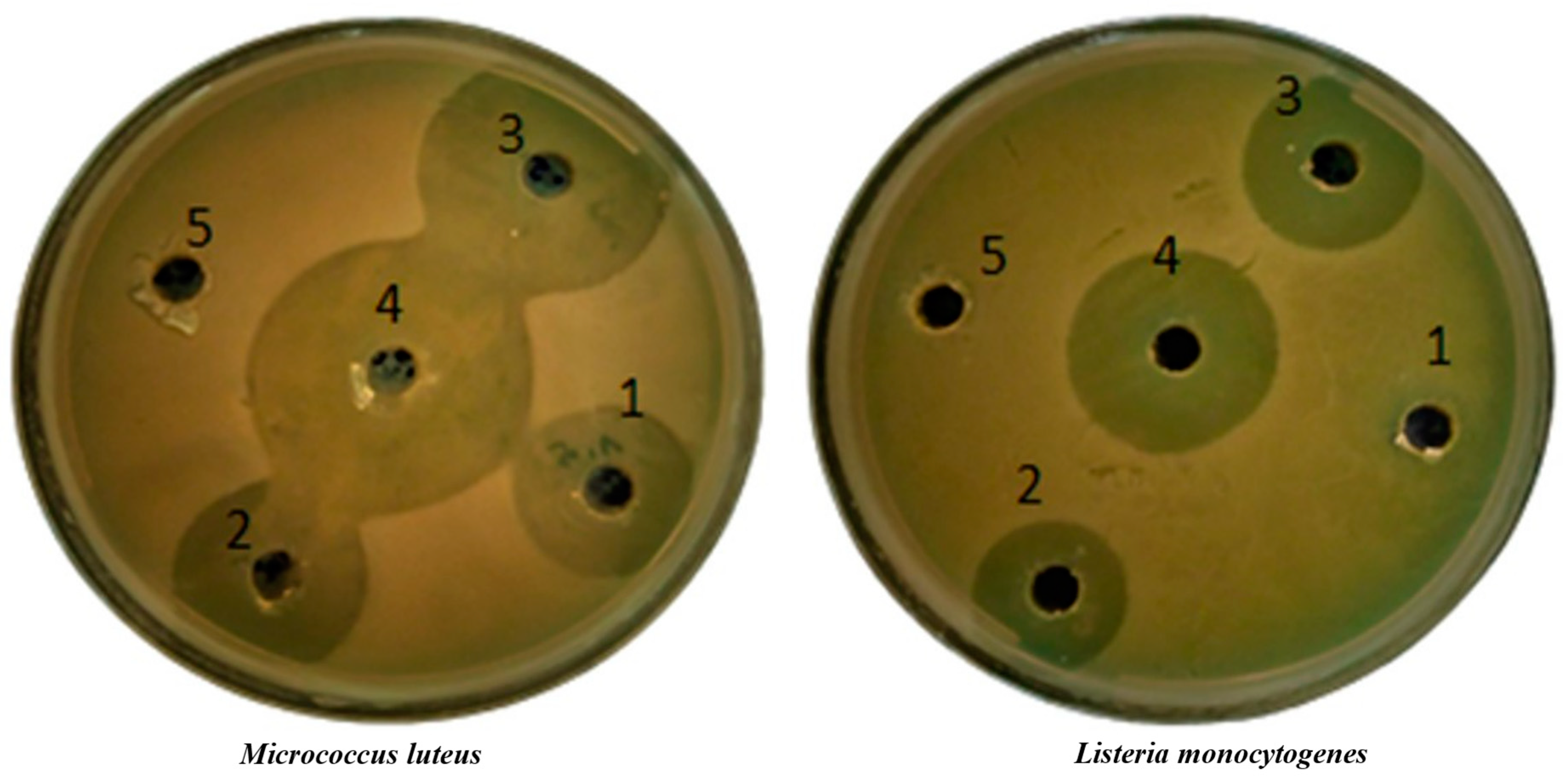
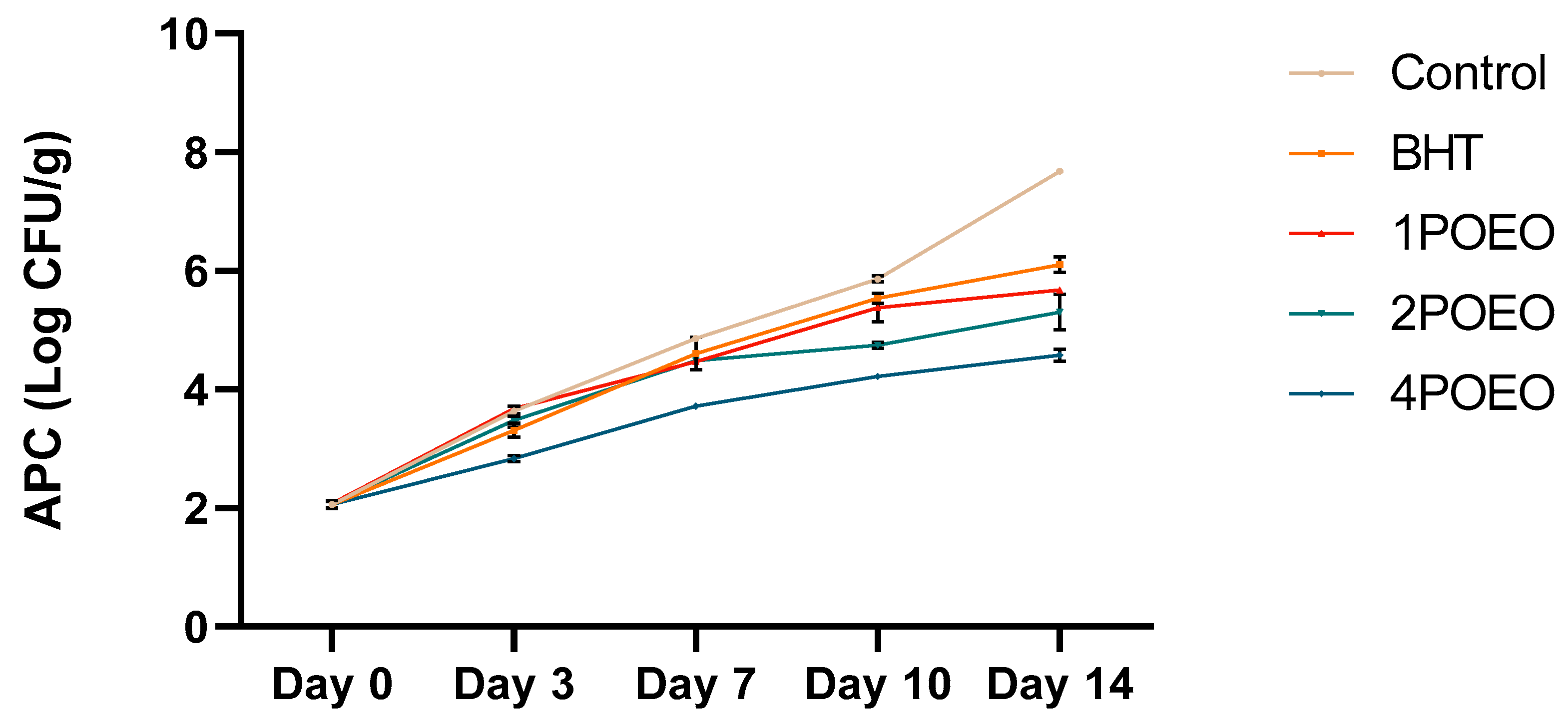
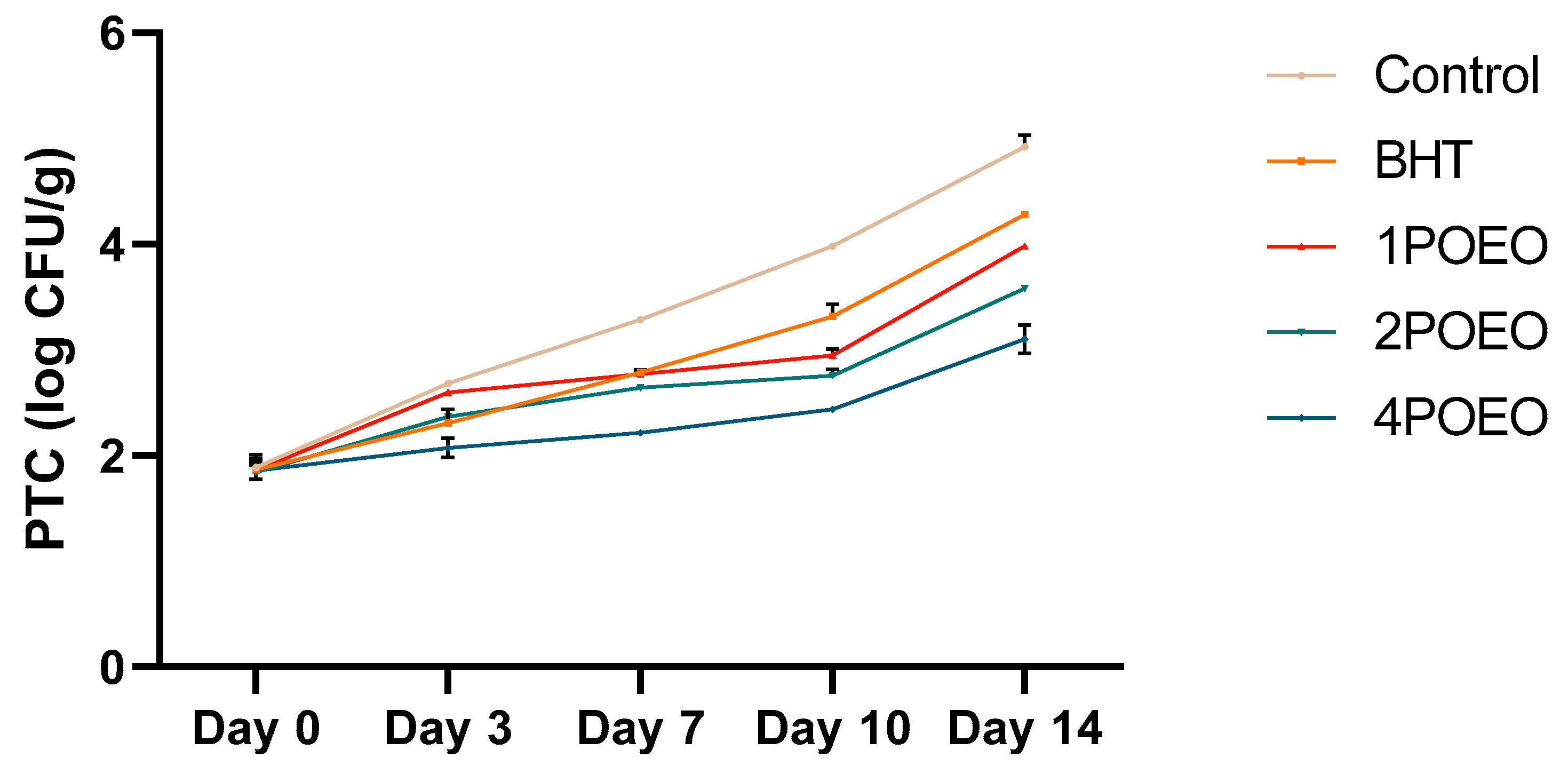
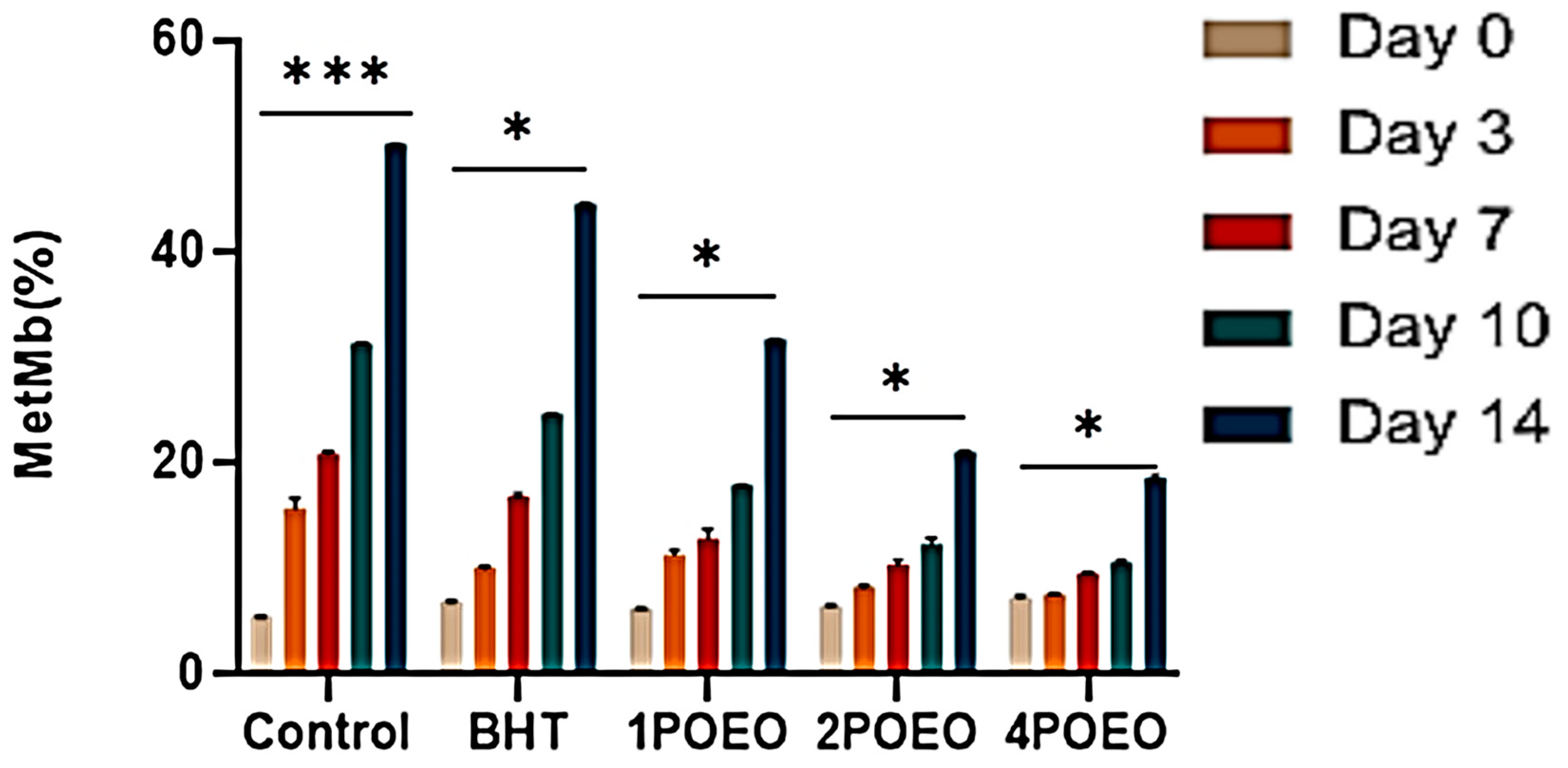
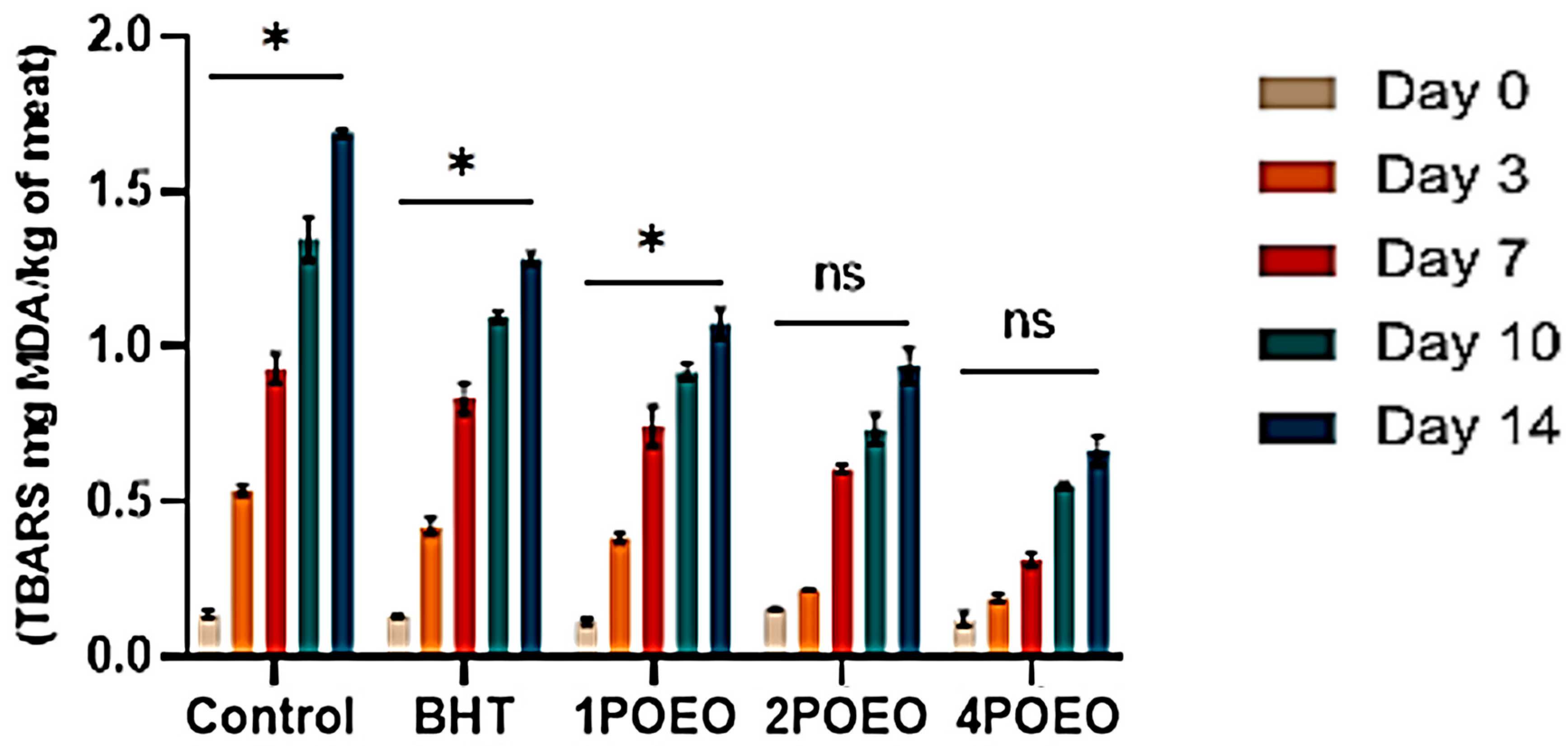


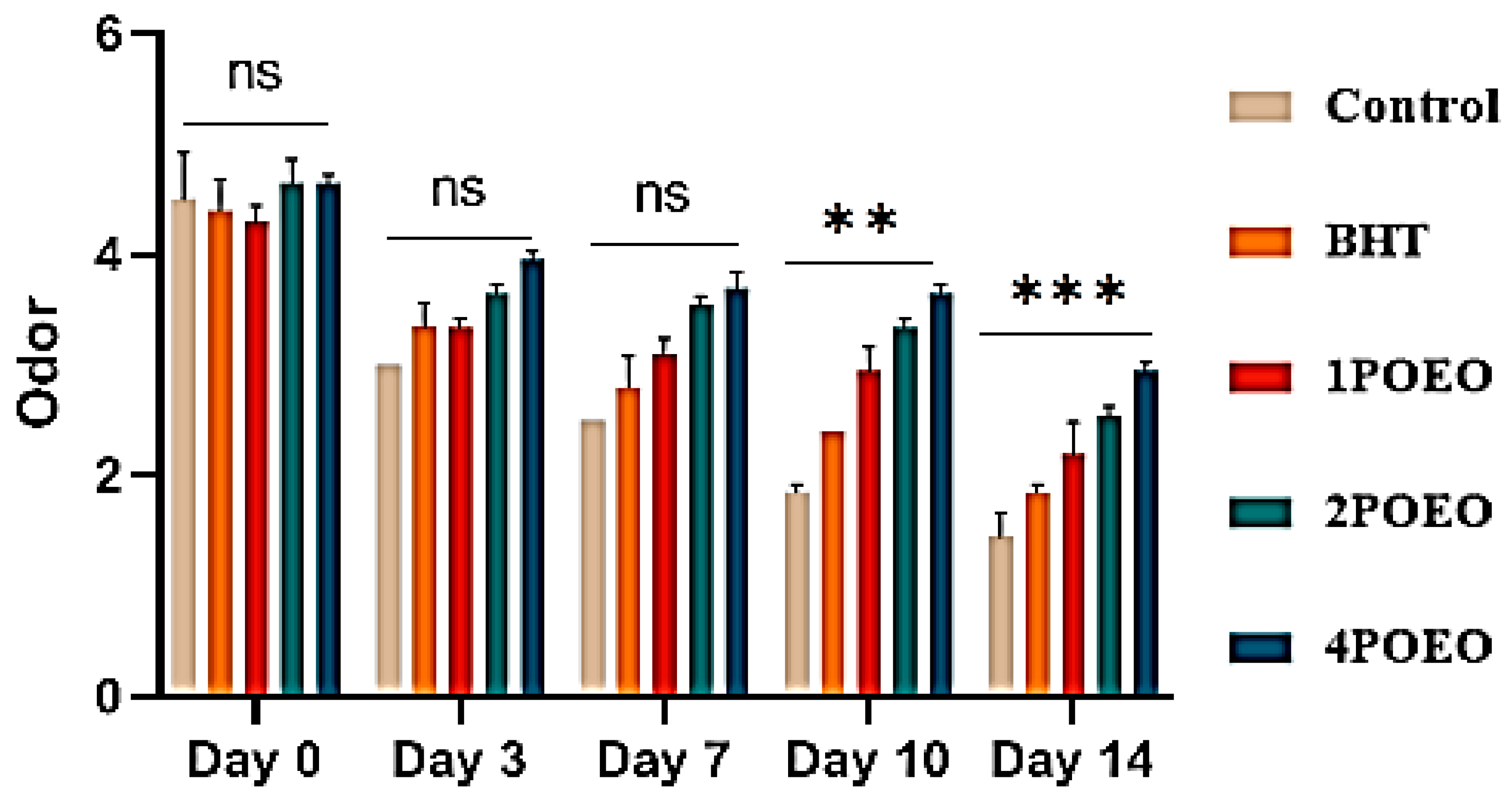
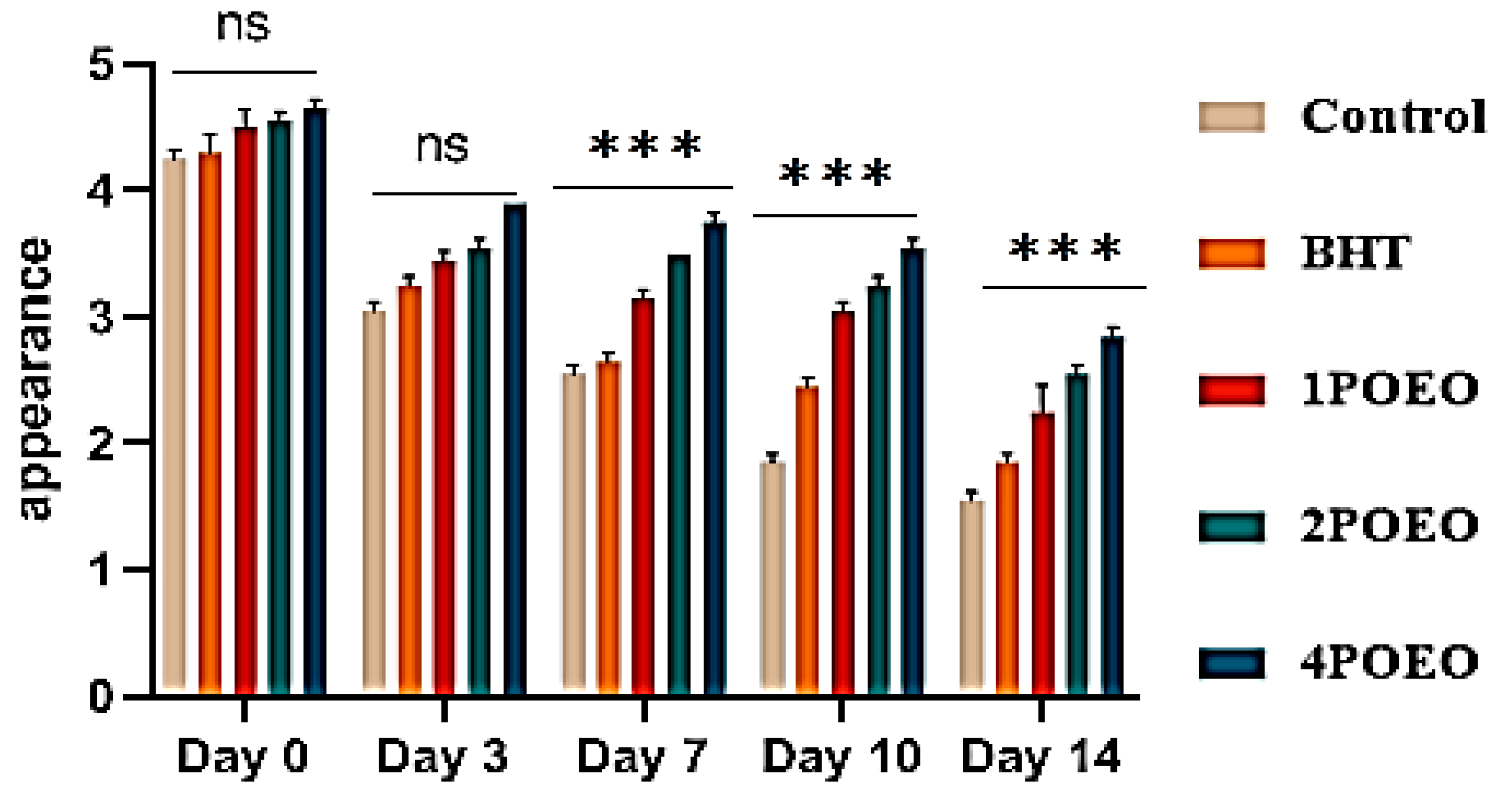
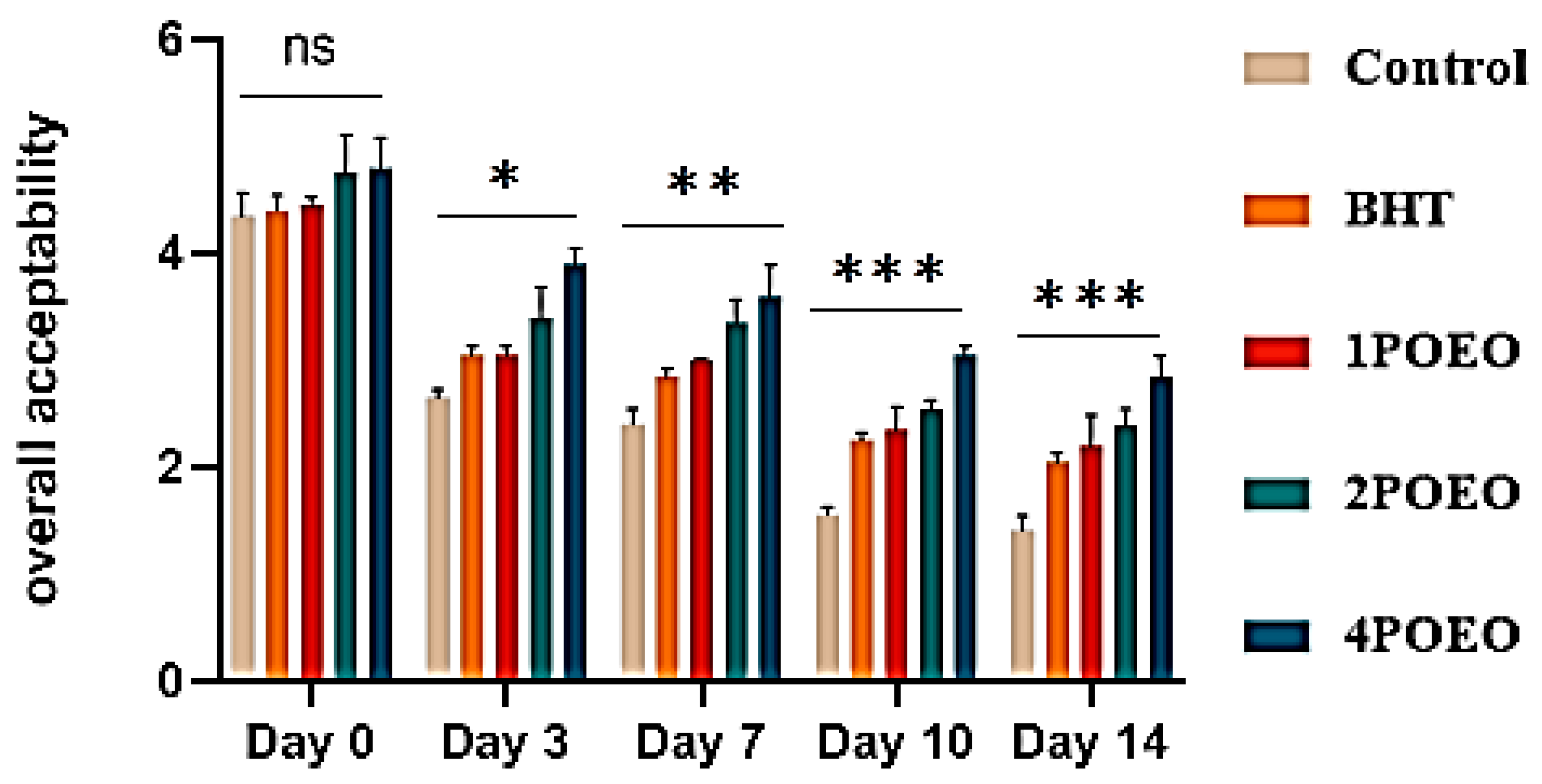
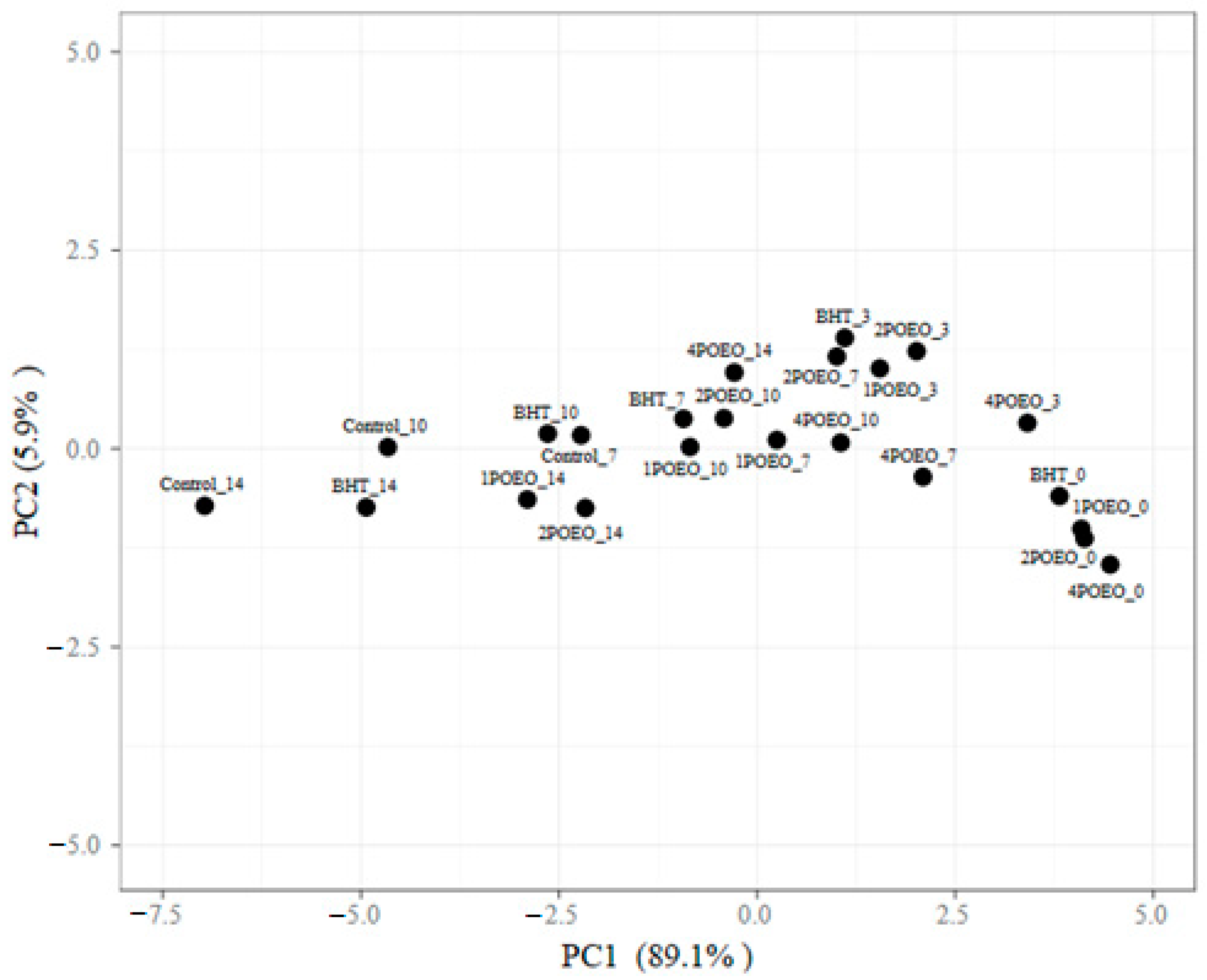
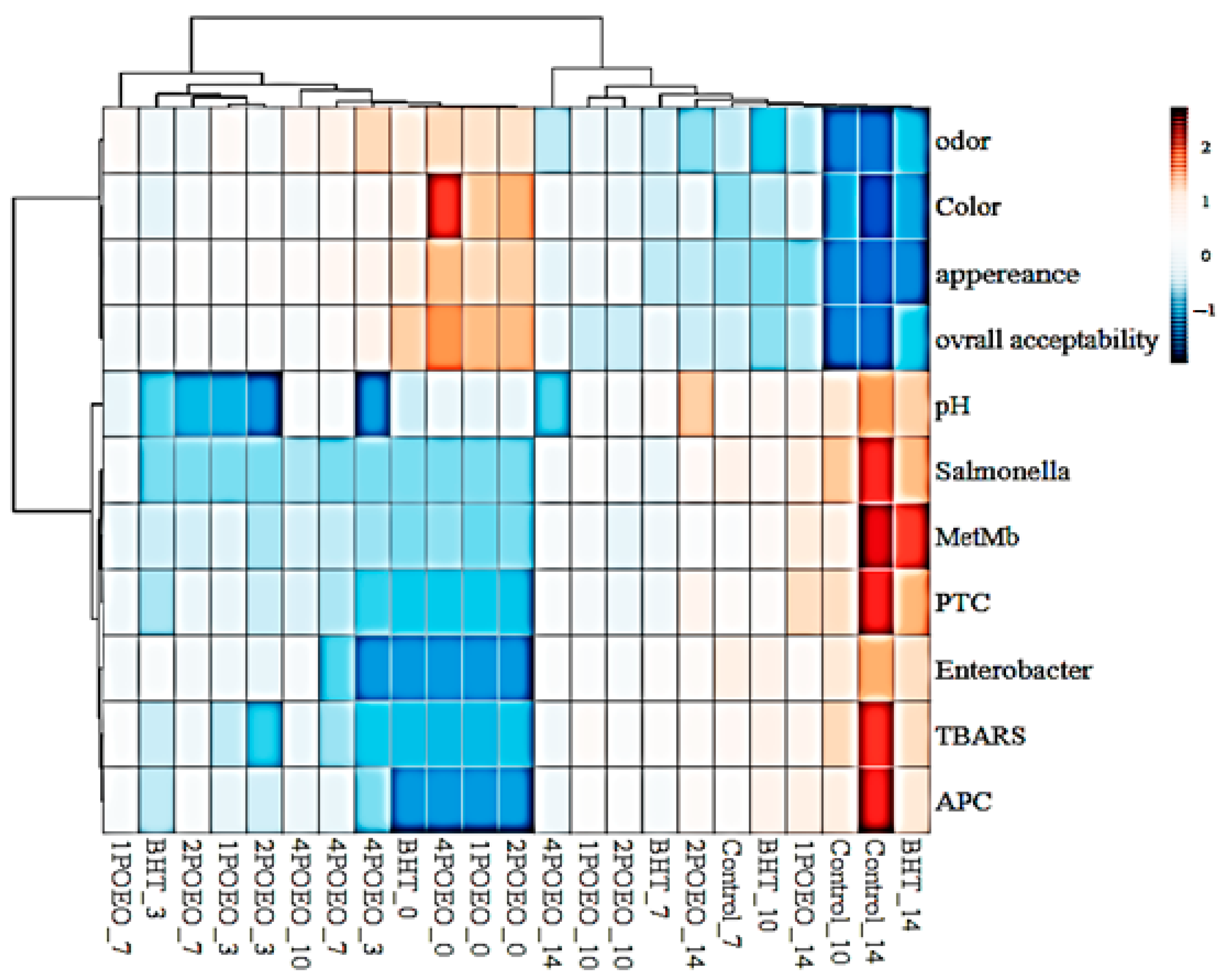
| N° | Component 1 | LRI 2 | LRI 3 | POEO (%) |
|---|---|---|---|---|
| 1 | β-thujene | 1120 | 1117 | 0.3 ± 0.02 |
| 2 | β-myrcene | 1170 | 1166 | 0.3 ± 0.02 |
| 3 | α-phellandrene | 1169 | 1177 | 0.1 ± 0.00 |
| 4 | limonene | 1200 | 1204 | 0.1 ± 0.00 |
| 5 | cis-β-ocimene | 1238 | 1243 | 0.2 ± 0.02 |
| 6 | trans-β-ocimene | 1265 | 1276 | 0.1 ± 0.00 |
| 7 | trans-rose oxide | 1378 | 1383 | 0.8 ± 0.02 |
| 8 | isomenthone | 1480 | 1484 | 7.4 ± 0.07 |
| 9 | linalool | 1531 | 1529 | 4.8 ± 0.05 |
| 10 | isopinocamphone | 1533 | 1530 | 0.1 ± 0.02 |
| 11 | (-)-β-bourbonene | 1538 | 1540 | 0.6 ± 0.02 |
| 12 | (-)-aristolene | 1570 | 1565 | 9.8 ± 0.05 |
| 13 | citronellyl formate | 1600 | 1605 | 12.6 ± 0.08 |
| 14 | citronellol acetate | 1637 | 1644 | 1.0 ± 0.02 |
| 15 | humulene | 1671 | 1667 | 0.3 ± 0.02 |
| 16 | citronellol | 1728 | 1730 | 40.0 ± 0.14 |
| 17 | α-selinene | 1748 | 1744 | 0.3 ± 0.02 |
| 18 | citronellyl butyrate | 1791 | 1786 | 1.3 ± 0.02 |
| 19 | nerol | 1793 | 1798 | 15.3 ± 0.07 |
| 20 | geranyl isobutyrate | 1811 | 1819 | 2.6 ± 0.03 |
| 21 | geranyl proprionate | 1827 | 1830 | 0.4 ± 0.02 |
| 22 | citronellyl tiglate | 1989 | 1991 | 0.7 ± 0.03 |
| 23 | cubenol | 2027 | 2030 | 0.5 ± 0.0.2 |
| 24 | phenyl ethyl tiglate | 2185 | 2190 | 0.3 ± 0.02 |
| 25 | geranic acid | 2360 | 2357 | 0.1 ± 0.01 |
| SUM | 100.0 | |||
| Monoterpenes | 6.8 | |||
| Oxygenated monoterpenes | 81.2 | |||
| Sesquiterpenes | 11.0 | |||
| Others | 1.0 |
| Tested EO | Pelargonium odoratissimum | Carbeniciline | ||
|---|---|---|---|---|
| Diameter of inhibition (mm) | ||||
| Concentrations | 25 (mg/mL) | 50 (mg/mL) | 10 (µg/mL) | 5 (µg/mL) |
| Gram-positive | ||||
| B. cereus ATCC 14579 | - | - | 24 ± 0.1 | 18 ± 0.03 |
| S. aureus ATCC 25923 | 13.0 ± 0.00 | 15.0 ± 0.00 | 22 ± 0.00 | 14 ± 0.02 |
| E. faecalis ATCC 29212 | 14.5 ± 0.21 | 27.5 ± 0.49 | 29 ± 0.34 | 16 ± 0.44 |
| M. luteus ATCC 1880 | 19.0 ± 0.00 | 29.0 ± 0.00 | 22 ± 0.33 | 19 ± 0.24 |
| L. monocytogenes ATCC 1911 | - | 21.0 ± 0.00 | 22 ± 0.17 | 13 ± 0.84 |
| Gram-negative | ||||
| P. aeruginosa ATCC 9027 | - | - | 23 ± 0.07 | 14 ± 0.01 |
| E. coli ATCC 25922 | 16.0 ± 0.00 | 26.0 ± 0.00 | 31 ± 0.05 | 18 ± 0.04 |
| S. enterica ATCC 43972 | - | - | 22 ± 0.05 | 12 ± 0.02 |
| Bacterial Strains | MIC | MBC | MBC/MIC | Interpretation |
|---|---|---|---|---|
| Gram-positive | ||||
| B. cereus ATCC 14579 S. aureus ATCC 25923 | 9.35 ± 7.99 9.35 ± 7.99 | 9.35 ± 7.99 11.25 ± 5.30 | 1 1 | Bactericidal Bactericidal |
| E. faecalis ATCC 29212 M. luteus ATCC 1880 | 5.6 ± 2.68 8.25 ± 9.54 | 9.35 ± 7.99 8.25 ± 9.54 | 2 1 | Bacteriostatic Bactericidal |
| L. monocytogenes ATCC 1911 | 9.35 ± 7.99 | 11.25 ± 5.30 | 1 | Bactericidal |
| Gram-negative | ||||
| P. aeruginosa ATCC 9027 | - | - | - | |
| E. coli ATCC 25922 | 8.25 ± 9.54 | 11.25 ± 5.30 | 1 | Bactericidal |
| S. enterica ATCC 43972 | 9.35 ± 7.99 | 11.25 ± 5.30 | 1 | Bactericidal |
| Carbenicillin | ||||
| Gram-positive | ||||
| B. cereus ATCC 14579 S. aureus ATCC 25923 | 3.125 ± 2.65 1.875 ± 0.88 | 0.0 0.0 | 2 2 | Bactericidal Bactericidal |
| E. faecalis ATCC 29212 M. luteus ATCC 1880 | 0.925 ± 0.45 2.500 ± 0.00 | 0.0 0.0 | 2 2 | Bactericidal Bactericidal |
| L. monocytogenes ATCC 1911 | 3.125 ± 2.65 | 0.0 | 4 | Bacteriostatic |
| Gram-negative | ||||
| P. aeruginosa ATCC 9027 | 1.875 ± 0.88 | 0.0 | 1 | Bactericidal |
| E. coli ATCC 25922 | 0.925 ± 0.45 | 0.0 | 6 | Bacteriostatic |
| S. enterica ATCC 43972 | 1.250 ± 0.00 | 0.0 | 3 | Bacteriostatic |
| Refrigerated Storage Days at 4 °C. (log10 CFU/g) | |||||
|---|---|---|---|---|---|
| Enterobacteriaceae | 0 | 3 | 7 | 10 | 14 |
| Control | <1 ± 0.00 aA | 2.29 ± 0.05 bC | 2.57 ± 0.03 cC | 2.72 ± 0.03 dD | 3.18 ± 0.20 eD |
| BHT | <1 ± 0.00 aA | 2.08 ± 0.02 bB | 2.16 ± 0.07 bcBC | 2.53 ± 0.01 cC | 2.84 ± 0.05 cC |
| 1POEO | <1 ± 0.00 aA | 1.87 ± 0.007 bB | 1.90 ± 0.05 bB | 2.17 ± 0.07 cB | 2.32 ± 0.02 cB |
| 2POEO | <1 ± 0.00 aA | 1.69 ± 0.003 aB | 1.95 ± 0.04 bB | 2.04 ± 0.03 bB | 2.25 ± 0.007 bB |
| 4POEO | <1 ± 0.00 aA | 1.08 ± 0.08 aA | 1.36 ± 0.04 aA | 1.98 ± 0.01 aA | 2.10 ± 0.04 bA |
| Salmonella spp. | 0 | 3 | 7 | 10 | 14 |
| Control | <1 ± 0.00 aA | <1 ± 0.00 aA | 1.68 ± 0.02 bC | 1.84 ± 0.06 cD | 2.20 ± 0.04 eD |
| BHT | <1 ± 0.00 aA | <1 ± 0.00 aA | 1.21 ± 0.001 bB | 1.55 ± 0.008 cC | 2.02 ± 0.16 cC |
| 1POEO | <1 ± 0.00 aA | <1 ± 0.00 aA | 1.33 ± 0.04 bB | 1.42 ± 0.03 cB | 1.74 ± 0.03 cB |
| 2POEO | <1 ± 0.00 aA | <1 ± 0.00 aA | <1 ± 0.00 bB | 1.34 ± 0.01 bB | 1.49 ± 0.06 bB |
| 4POEO | <1 ± 0.00 aA | <1 ± 0.00 aA | <1 ± 0.00 aA | 1.03 ± 0.01 aA | 1.32 ± 0.01 bA |
Disclaimer/Publisher’s Note: The statements, opinions and data contained in all publications are solely those of the individual author(s) and contributor(s) and not of MDPI and/or the editor(s). MDPI and/or the editor(s) disclaim responsibility for any injury to people or property resulting from any ideas, methods, instructions or products referred to in the content. |
© 2024 by the authors. Licensee MDPI, Basel, Switzerland. This article is an open access article distributed under the terms and conditions of the Creative Commons Attribution (CC BY) license (https://creativecommons.org/licenses/by/4.0/).
Share and Cite
Ben Hsouna, A.; Ben Akacha, B.; Generalić Mekinić, I.; Čmiková, N.; Ben Belgacem, A.; Bouteraa, M.T.; Ben Saad, R.; Mnif, W.; Kluz, M.I.; Kačániová, M.; et al. Insight into Pelargonium odoratissimum Essential Oil Preservative Properties Effect on Ground Beef. Foods 2024, 13, 3181. https://doi.org/10.3390/foods13193181
Ben Hsouna A, Ben Akacha B, Generalić Mekinić I, Čmiková N, Ben Belgacem A, Bouteraa MT, Ben Saad R, Mnif W, Kluz MI, Kačániová M, et al. Insight into Pelargonium odoratissimum Essential Oil Preservative Properties Effect on Ground Beef. Foods. 2024; 13(19):3181. https://doi.org/10.3390/foods13193181
Chicago/Turabian StyleBen Hsouna, Anis, Boutheina Ben Akacha, Ivana Generalić Mekinić, Natália Čmiková, Améni Ben Belgacem, Mohamed Taieb Bouteraa, Rania Ben Saad, Wissem Mnif, Maciej Ireneust Kluz, Miroslava Kačániová, and et al. 2024. "Insight into Pelargonium odoratissimum Essential Oil Preservative Properties Effect on Ground Beef" Foods 13, no. 19: 3181. https://doi.org/10.3390/foods13193181










